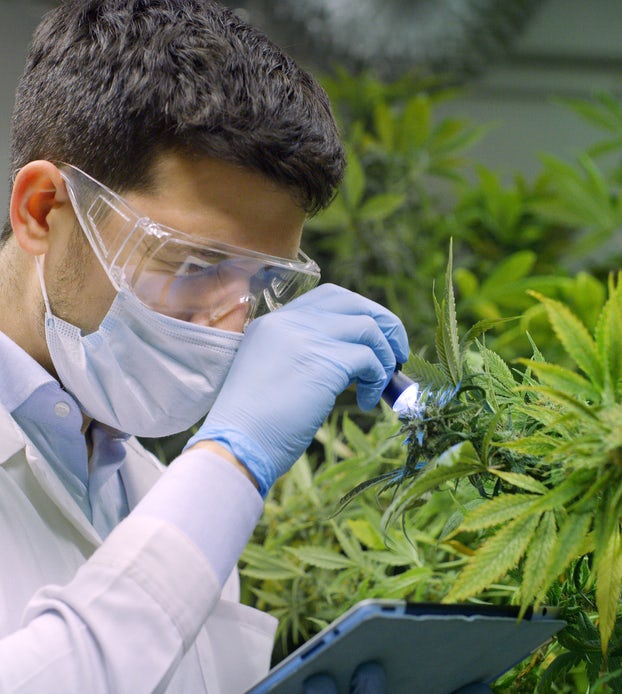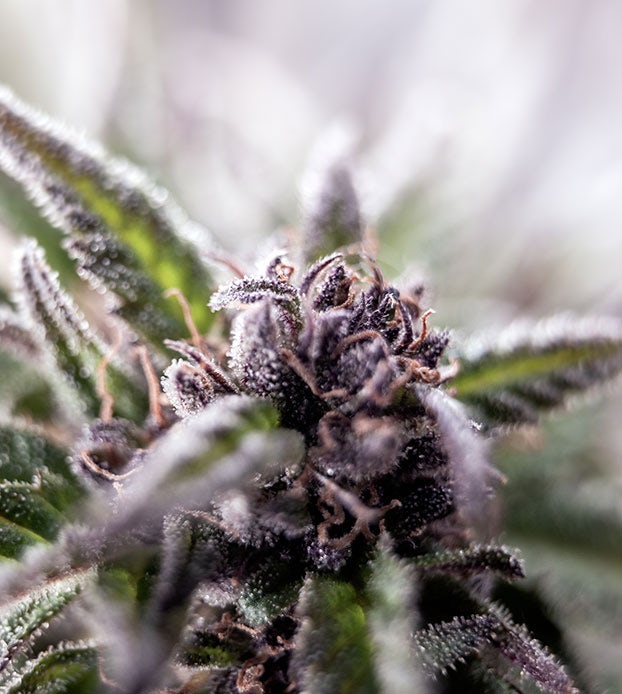A thoughtful gesture from a colleague, a break in the rain on your walk home, or the memory of an inside joke told years before — there are all types of moments that can boost happiness and foster a sense of mental wellness, but there’s also something else at play.
Inside of each and every one of us is a neurotransmitter called anandamide, also known as the “bliss molecule.”
What is anandamide?
To understand anandamide, one must first look at the endocannabinoid system (ECS).
Discovered by scientists in the early 1990s, the ECS modulates many basic functions throughout the body, including sleep, pain, memory, inflammation, and hunger.
The system has a number of receptors (such as CB1 and CB2) that are triggered by cannabinoids produced within the human body (endocannabinoids). This system can also be activated by phyto-cannabionids (the main active chemicals in cannabis), which is how cannabis is able to affect so many different processes in the body.
Cannabinoids and endocannabinoids
Cannabinoid is a term used to describe compounds found in cannabis, such as tetrahydrocannabinol (THC) and cannabidiol (CBD).
After scientists discovered the ECS they learned that the human body produces its molecules that are very similar to phyto-cannaboinids, and which can affect the receptors of the ECS. So far, two of these “endocannabinoids” have been identified: Anandamide (often called AEA) and 2-arachidonoylethanolamine (2-AG).
Both AEA and 2-AG bind to CB1 and CB2 receptors, but research has shown that only 2-AG functions as a full agonist of the endocannabinoid system. THC works similarly to AEA as a partial agonist of CB1 and CB2, meaning that it binds to the receptors and produces a partial biological response. THC being a partial agonist is actually one reason it is so remarkably safe, as it only able to stimulate a partial response even at high doses (an effect known in pharmacology as the ceiling effect).
Discovering anandamide — in pig brains
The name anandamide comes from ananda, a Sanskrit word meaning bliss or happiness. The endocannabinoid was first discovered in 1992 by Lumir Hanus, Bill Devane, and Raphael Mechoulam at the Hebrew University of Jerusalem in 1992.
In their research paper on the discovery, the scientists stated that N-Arachidonylethanolamide (anandamide or AEA), which they found in pig brains, “may function as a natural ligand for the cannabinoid receptor.”
What does this mean? If we think of the cannabinoid receptors located on cells throughout the body as locks, then endocannabinoids like anandamide are produced to serve as a sort of key to unlock their functions.

What anandamide does
Since its discovery, hundreds of research studies have attested to a wide range of functions of “the bliss molecule.”
A 2017 study published in “Frontiers in Molecular Neuroscience” took a broad look at the research compiled on anandamide over the 25 years since its discovery. The study stated that AEA has a “multifaceted ability” to impact “virtually every system of the human body,” including both the central and peripheral nervous systems.
One of the more well-established roles is in mental health.
Stress and mental health
A 2014 study found that AEA levels can play a key role in how the body handles stress, and that decreased AEA levels corresponds with increased anxiety-like behavior. A study published a year later stated that increased AEA levels could help enhance extinction learning, and that AEA-enhancing drugs “could promote extinction learning during psychotherapeutic interventions.”
How could this play out in terms of mental health? The extinction of fear memories is a key goal of behavioral treatment for post-traumatic stress disorder (PTSD). A 2018 study discussed how elevated levels of anandamide (as a result of inhibition of the fatty acid amide hydrolase FAAH) promotes fear extinction, suggesting “that AEA signaling can temper aspects of the stress response and that FAAH inhibition may aid the treatment for stress-related psychiatric disorders, such as PTSD.”
AEA and the runners high
We’ve all heard of the runners high, but many do not know the endocannabinoid system is responsible for the phenomenon.
According to a 2003 study, moderate intensity exercise activates the endocannabinoid system and produces higher levels of anandamide. The study concluded that anandamide – not endorphins – produces the euphoria often called runner’s high. Similar findings appeared in a 2015 study performed on mice, which concluded that running increases blood levels of anandamide (as well as β-endorphin), and that “cannabinoid receptors mediate acute anxiolysis and analgesia after running.”
That study followed one in 2012 that examined 11 male cyclists, and found that AEA levels increased during exercise and the 15 minute recovery period, potentially indicating that anandamide plays a role in the antidepressant effects of exercise.
Anandamide and brain reward circuitry
Could anandamide potentially play a role in addiction treatment? A 2018 review looked at previous studies on endocannabinoids which demonstrated that “anandamide exerts an overall modulatory effect on the brain reward circuitry. Several reports suggest its involvement in the addiction-producing actions of other abused drugs, and it can also act as a behavioral reinforcer in animal models of drug abuse.”
They also stated that drugs which block AEA metabolism can counteract some of the behavioral or reinforcing effects of drugs like nicotine, alcohol, and opiates, “suggesting potential therapeutic activity against substance use disorders.”
Among the previous research on the matter, a 2008 study found that the evidence suggests the ECS “has an important role in signalling of rewarding events,” and that the activation of CB1 “produces rewarding effects and increases rewarding effects of abused drugs and foods.”
The researchers stated that brain levels of anandamide and 2-AG “are altered by activation of reward processes,” but added that the intrinsic activity of the ECS does not necessarily facilitate the brian stimulation reward, and may actually have the opposite effect.
The ECS is incredibly important for regulating our response to rewarding, risky, or gratifying behaviors. Anandamide and the endocannabinoid system are intertwined with the central mechanisms that underlie drug and non-drug rewarding behaviours.1 Targeting the endocannabinoid system for treating diseases such as gambling, sex, and food addiction make sense when you recognize the import role endocannabinoids play in the rewards pathway.
Anandamide and homeostasis
Homeostasis refers to a sense of balance or equilibrium in the body. When things are off kilter, the human body releases signals to maintain balance, a process that is known as feedback regulation.
The ECS plays a central role in ensuring homeostasis by affecting many different bodily functions. For instance, energy homeostasis, the way the human body regulates energy levels through food intake, metabolism, and other processes. By stimulating CB1, endocannabinoids can increase appetite, helping the body get the energy or nutrients it needs. When we introduce THC, which can activate CB1 receptors, we hijack this regulatory ECS and overload it with signals to eat. This is how the munchies happen.
Anandamide also plays a central role in preserving immune homeostasis, by maintaining immunological health in the gut.
Cannabinoid receptors can be found on many cell types around the body and function as regulators of immunity, energy, and sensation (like pain). Anandamide and other endocannabinoids interact with these receptors to help maintain the function of our body systems.

Anandamide and hypertension
Research has shown that the ECS is “overactivated in arterial, pulmonary, and portal hypertension,” and plays “an important cardiovascular regulatory role,” including with regards to hypertension. The impact of the ECS on the cardiovascular system has even led researchers to call for new cannabinoid-based treatments for hypertension.
Anandamide and epilepsy
Cannabis has a well-established role in treating epilepsy. The only FDA approved cannabis-derived medication is cannabidiol (Epidiolex), a 10% oral solution approved to treat rare forms of the disease.
Research has shown that cannabinoids can be neuroprotective and that the ECS plays a key role in regulating synaptic communication in the central nervous system. Anandamide specifically has been shown to have a protective effect against seizures — at least on fruit flies.
Anandamide and obesity
Endocannabinoids can play a role in weight loss and weight gain, by helping regulate eating behavior. Researchers have found that activating ECS receptors can stimulate feeding, while there is some indication that blocking receptors could lead to reduced caloric intake and weight loss. In rodent studies, anandamide has shown to activate cannabinoid receptors and cause overeating. In addition, a 2005 study found significantly higher levels of AEA in women with anorexia nervosa, suggesting that it may play a role in the addictive or psychological aspects of the eating disorder.
Anandamide and schizophrenia
Research has shown that the functioning of the ECS can be related to schizophrenia, including a 2003 study that found that patients with schizophrenia had significantly higher levels of anandamide in their blood. The researchers stated that this indicates that ECS signalling could be altered in the nervous system and blood during the acute phase of schizophrenia. A study the following year found that the level of anandamide in cerebrospinal fluid is eight times higher in certain schizophrenics.
We also know that chronic THC use, especially at a young age, increases the likelihood of developing schizophrenia, though it seems to be mostly only in those genetically predisposed to mental illness. It is clear that anandamide and the ECS are involved in schizophrenia, but more research must be done to find a good way to use this information clinically.
Anandamide and migraines
Clinical observations have shown that AEA levels are reduced in the cerebrospinal fluid and plasma of chronic migraine patients. In 2011, researchers carried out a clinical study that involved administering AEA to rats. The study confirmed “that a dysfunction of the endocannabinoid system may contribute to the development of migraine attacks and that a pharmacological modulation of [cannabinoid] receptors can be useful for the treatment of migraine pain.”
Anandamide and Huntington’s disease
Researchers have suggested that Huntington’s disease is one of a number of health conditions that could result from irregularities in the ECS. Cannabinoid receptor activation of immune cells and neurons could have antioxidant, anti-inflammatory effects, and numerous other neuroprotective effects. In addition, anandamide can mediate synaptic plasticity in rodent models, leading researchers to suggest that targeting this plasticity deficit could be part of future treatments for Huntington’s disease.
Anandamide and multiple sclerosis
A 2007 clinical trial found that anandamide levels were higher in relapsing MS patients, suggesting that targeting the ECS could be useful in treating MS. Other research has concluded that using pharmacological tools that target the ECS could help in the treatment of neurodegenerative conditions, including MS.
Anandamide and pain
Chronic pain is the most common condition treated by medical cannabis patients in the United States. Research has shown that when the body senses pain, anandamide can block pain signalling by binding to CB1. Researchers have stated that anandamide signalling could potentially lead to a new way to provide pain therapy and that medications that include cannabinoid receptor agonists (which is how THC works) or that enhance endocannabinoid function could also be effective in treating disorders that include pain as a symptom.
Anandamide and food
Consuming certain foods could potentially increase the levels of anandamide in your body. This can be done by consuming food that influences the production of the fatty acid amide hydrolase (FAAH), an enzyme which breaks down anandamide.
The flavonoid kaempferol has also been found to inhibit FAAH. It can be found in a wide variety of foods, including apples, tomatoes, potatoes, blackberries, and lettuce, to name just a few. And while truffles may not be a daily staple for most people, they do contain anandamide, leading scientists to posit that perhaps anandamide might have been what attracted ancient truffle eaters to the fungus.
In addition, cocoa powder and chocolate have actually been found to contain N-acylethanolamines, which are cannabinoid-like molecules that can reduce endocannabinoid breakdown.
It should be noted that research has concluded that the levels of AEA and 2-AG in food is “several orders of magnitude” below those required to achieve observable central effects in the body.
The types of fats we eat can also impact anandamide and endocannabinoid levels. Increasing intake of linoleic acid, a polyunsaturated omega-6 fatty acid abundant in a variety of cooking oils, elevated AEA levels in mice in a clinical study. Omega-3 fatty acids are considered to be heart healthy, reducing the risk of some cardiovascular disease, and showing promise in mood disorders. Part of these beneficial effects of consuming omega-3 fats could be from the balancing of omega-3 and omega-6 endocannabinoid production.2 Saturated or monounsaturated fats can be used by the body to form N-acylethanolamines, which are more abundant than anandamide and influence endocannabinoid tone.
CBD and anandamide
Cannabidiol, the non-psychotropic cannabinoid popular in dietary and health supplements, can actually enhance anandamide signaling, leading researchers to conclude that it could have a role in the future as a treatment to treat schizophrenia.
CBD can inhibit FAAH, thus increasing anandamide levels. Researchers have concluded this could indicate that CBD could potentially be effective in treating anxiety-related disorders by way of inhibiting FAAH.
How to increase anandamide levels
While adopting an all-truffles diet is probably not an option for most people, eating a diet that is rich in foods that contain lots of healthy fats, fresh fruits and veggies, and rich with herbs and spices might be a more reasonable goal. These foods contain many terpenes, flavonoids, FAAH, and could potentially boost levels of the endocannabinoid.
As was covered earlier, regular, moderate exercise and physical activity can be an effective way to boost anandamide levels — as well as just happiness in general. Research is still scant, but meditation has been shown to help increase endocannabinoid levels and feelings of well-being and happiness. In general, a daily routine that leans heavily on activities that increase positive feelings, such as socializing with loved ones, could also improve overall happiness, regardless of how anandamide levels are impacted.
Sources
- Fattore, L., Melis, M., Fadda, P., Pistis, M., & Fratta, W. (2010). The endocannabinoid system and nondrug rewarding behaviours. Experimental neurology, 224(1), 23–36. https://doi.org/10.1016/j.expneurol.2010.03.020
- Watson, J. E., Kim, J. S., & Das, A. (2019). Emerging class of omega-3 fatty acid endocannabinoids & their derivatives. Prostaglandins & other lipid mediators, 143, 106337. https://doi.org/10.1016/j.prostaglandins.2019.106337
Sign up for bi-weekly updates, packed full of cannabis education, recipes, and tips. Your inbox will love it.

 Shop
Shop Support
Support
















